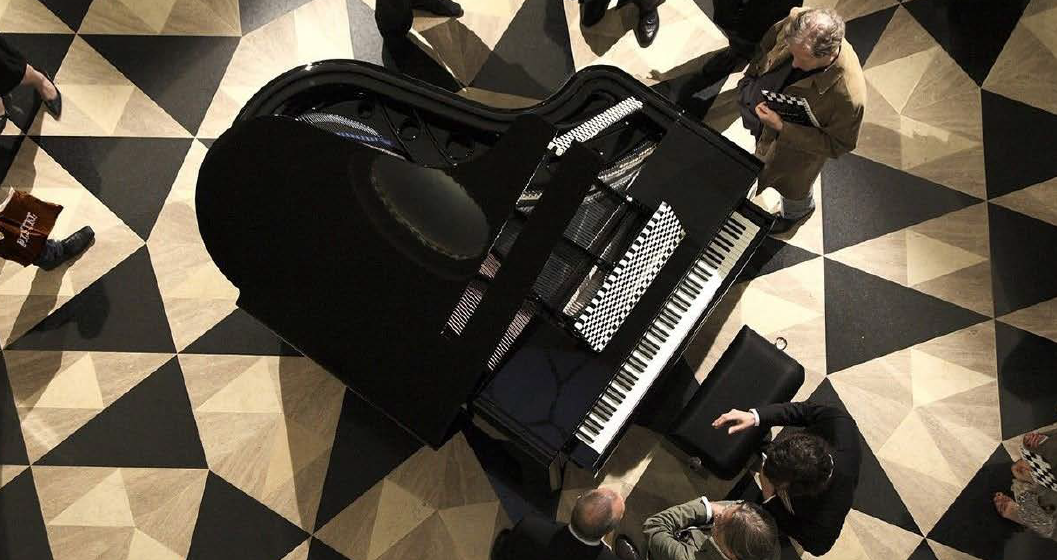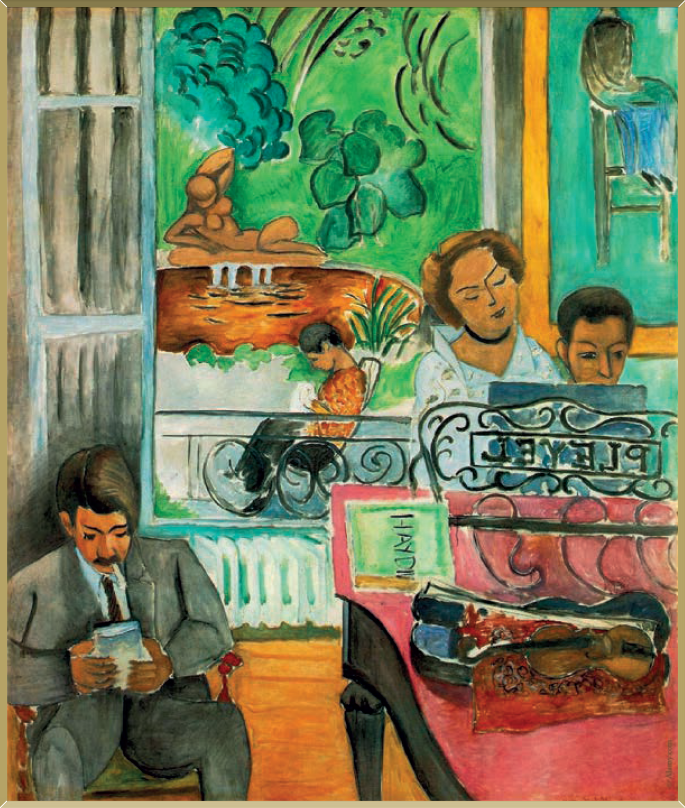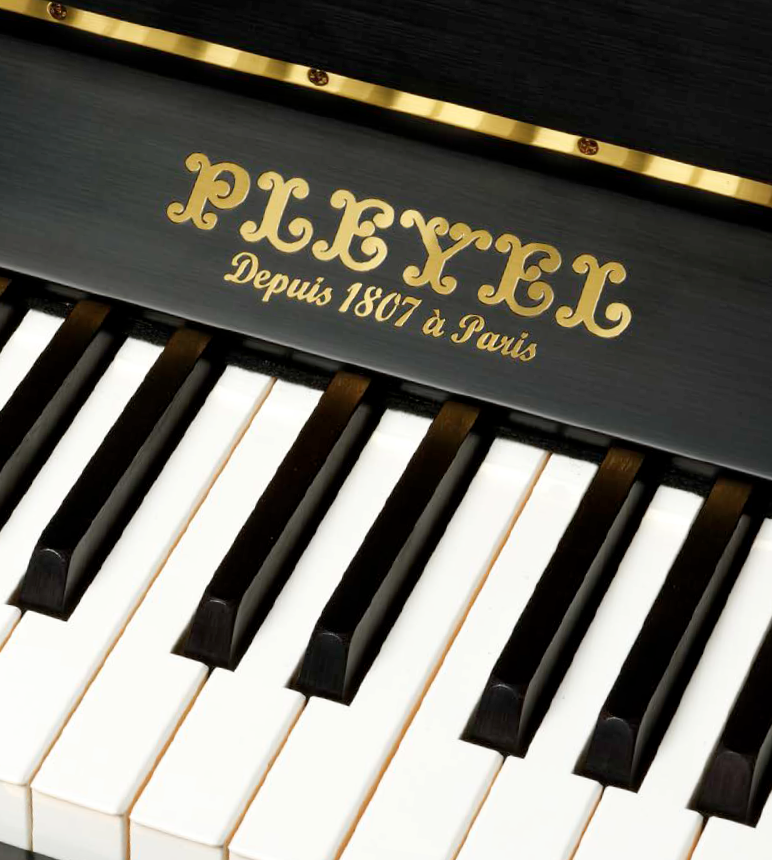The Relaunch of Pleyel in France – Produced Far Away
Last year, the completely new Pleyel instruments from the Algam company, which bought the brand in 2007, was presented to distributors. For the first time since Pleyel was founded in 1807, its pianos are made outside Europe.

22 degrees Celsius, 52.1% humidity; all the conditions are right. On the walls, the thermometers are constantly alert. If there is even the slightest anomaly, alarms sound in all the rooms in the building: the thirty or so pianos stored there would not tolerate an extreme change in temperature or humidity. From deep within the building, a few notes are heard now and then: the young technician Albane Girard, a graduate of the ITEMM (Institut technologique européen des métiers de la musique) in Le Mans, is putting the finishing touches to upright piano while her colleagues install the dampers of a baby grand, stripped of its keyboard.
We are in Thouaré-sur-Loire, a few kilometres from Nantes, in an annexe on the premises of the manufacturer and distributor of musical equipment Algam. The annexe has been converted into a workshop to cater for the firm’s new activity. In 2017 the company, whose turnover exceeds 115 million euros, acquired the Pleyel brand which, four years earlier, had announced the cessation of its activities.
In a few weeks, the pianos will be presented to French retailers. This is a crucial step for all the employees who are busy making the final adjustments to the pianos that have been ‘resting’ for a few months. ‘The pianos arrive ready-assembled but everything moves all the time. Even once an instrument is in the shop, the technician may well go over it one more time’, explains Albane.
Like her, Jean and Virginie only joined the team last June, more or less at the same time that the pianos arrived, transported in containers from Indonesia. Because, although they are designed in France, most of the Algam Pleyels are manufactured outside Europe – something new in the history of the brand.
Decline

When Pleyel inspired legendary painters…
Henri Matisse – The music lesson (1917)
In 1961, Pleyel merged with Gaveau-Érard; this lasted until 1970. A year later, the German manufacturer Schimmel took over Pleyel for some twenty years, until the brand was briefly taken over by Musique Partenaires in 1994, and subsequently sold to the Rameau company, based in Alès (Gard).
In 2000 Hubert Martigny, co-founder of the technology consulting company Altran, bought the factory. Pleyel continued to operate but its products could not compete with the earlier pianos. ‘The sonority of the pianos had nothing in common with the Pleyels from the beginning of the twentieth century. It was actually a factory with more than a hundred workers, producing nearly 2,000 pianos a year’, says Stephen Paulello, the last independent French maker.
At the same time, competition from Asia was increasingly tough and sales of new pianos were declining. In 2007, faced with this situation, Hubert Martigny decided to take the brand in a new direction. The Alès factory closed and Pleyel returned to its historic home in Saint-Denis to refocus on the top end of the market. The brand produced no more than about twenty designer instruments a year, which were virtually works of art.
In 2013 the brand announced the end of production, only a few months after its acquisition by the venture capital company ‘Développement et partenariat’ owned by Didier Calmels; this resulted in the dismissal of 14 employees. According to the Pleyel website: ‘Like other European piano brands, in 2013 Pleyel closed its factory, located in the Paris region, owing to excessive labour costs and the impact of low-cost pianos from Asia.’
Algam buys Pleyel
Four years later, Algam took over the brand with one particular aim: to rediscover the historic Pleyel sound – the ‘French romantic sound’ – and combine it with the power of modern pianos. Pianist Yves Henry became the brand’s ambassador.
The new owners decided to move production of the mid-range ‘Heritage’ pianos to Asia and of the top-of-the-range ‘Haute facture’ instruments to Germany. The soundboards were made in Italy by Ciresa.
 Only the design and the tuning would take place in France, all overseen by an instrument maker that the company brought in from Germany: Patrick Horn-Wegner, assisted by Pascal Reimers. The latter designed all the instruments in France, in the workshop in Thouaré-sur-Loire, staring from original Pleyel drawings. ‘His job was to seek out the best manufacturers. He spent almost a year in Indonesia doing so, and also training the chosen suppliers in production methods and teaching them how to manufacture the parts according to his designs – bearing in mind that there are more than 12,000 parts in a piano, of which 10,000 are moving parts, more than 220 strings, and so on.
Only the design and the tuning would take place in France, all overseen by an instrument maker that the company brought in from Germany: Patrick Horn-Wegner, assisted by Pascal Reimers. The latter designed all the instruments in France, in the workshop in Thouaré-sur-Loire, staring from original Pleyel drawings. ‘His job was to seek out the best manufacturers. He spent almost a year in Indonesia doing so, and also training the chosen suppliers in production methods and teaching them how to manufacture the parts according to his designs – bearing in mind that there are more than 12,000 parts in a piano, of which 10,000 are moving parts, more than 220 strings, and so on.
The pianos are designed entirely by Pleyel. The parts are machined according to specifications unique to our brand in workshops that are especially dedicated to Pleyel’, explains Algam’s Antoine Kimmel. ‘We started from the old Pleyel drawings to be sure of having the right foundation for the sound, and then we tried to improve them’, adds Patrick Horn-Wegner.
Mass production
Was it necessary to relocate to Asia in order to revive Pleyel? For Stephen Paulello, the instrument builder who, in Hubert Martigny’s time, had participated in the design of one of the pianos, this approach makes little sense: ‘The only way to compete is by doing something entirely new… What’s the point of mass producing pianos when there is already a vast amount of production in China?
At the moment, even firms like Steinway or Yamaha are having to reduce their production because the cost of new pianos is constantly increasing and because there is a plentful supply of second-hand ones. And then, how can the Pleyel sound be recreated by relocating production?
I would have been more interested in taking pianos from the 1910s and 1920s and installing a modern action so that the piano retains its sound identity.’ During the ‘Développement et partenariat’ period, the maker had entered into talks with Bernard Roques to resume the manufacture of Pleyel pianos but the discussions came to nothing. ‘We had found ways of developing Pleyel here in France. I could have directed both organizations, both the manufacture of the Pleyels and also that of the Paulellos’, says the instrument builder with a little bitterness.
For him, the takeover of the brand by Algam retains nothing but the name of Pleyel. ‘Relaunching mass production of Pleyels and, moreover, in Indonesia, is of no interest to me. It’s is more about business than art. It’s taking advantage of a brand that used to be prestigious, which had a sound identity and, above all, was interested in how the instruments were constructed’, he says with regret. ‘And then we have to bear in mind that since the 1930s Pleyel’s fame has been restricted primarily to France.
Other then in China, where it still enjoys a certain prestige, the brand is not widely recognized either in Europe or in the USA. China is moreover one of Algam’s major targets, as it is by far the largest market, with 300,000 new pianos sold each year out of a worldwide total of 400,000 – compared to 6,000 in France. ‘Once you know that, there is of course a logic to having some of the production in Asia. A lot of piano manufacturers are there and in the end, like all emerging industries, with the passage of time, they become very good’, observes Antoine Kimmel.
The initial prices for the ‘Heritage’ range are in the region of €13,000 – €15,000, depending on the size, and €25,000 euros for the grand pianos. For the ‘Haute facture’ range, prices start at around €80,000. These instruments are more affordable than those from the era of designer pianos, and are more targeted at amateur and professional pianists.
Article by Flore Caron
A graduate of the Tours School of Journalism, Flore Caron is a journalist, notably for France Télévision. She obtained her Diplôme d’études musicales in transverse flute at the Dijon Conservatoire. In 2021, she joined the editorial staff of ‘La Lettre du Musicien’.
This article is a contribution from the French magazine La Lettre du musicien through Piano Street’s International Media Exchange Initiative and the Cremona Media Lounge.
 La Lettre du musicien is a periodical music magazine published in Paris, France, fifteen times a year for music professionals. Created in 1984, it is devoted to classical and electroacoustic music and reports on current musical events in France in this field as well as on pedagogy. Once a year, it publishes a special edition dedicated to the piano.
La Lettre du musicien is a periodical music magazine published in Paris, France, fifteen times a year for music professionals. Created in 1984, it is devoted to classical and electroacoustic music and reports on current musical events in France in this field as well as on pedagogy. Once a year, it publishes a special edition dedicated to the piano.
Resources:
Comments
Please let me know if the keys are standard size. Chopin’s Pieyel had more narrow keys.
Thanks you,
Patricia Cachopo
Yes the keys have standard sizes. The new (2021) Pleyel pianos meet the current German standards of piano construction. They are constructed under the supervision of the German pianomaster Patrick Horn Wegner.
https://www.112piano.com/diensten-tarieven/intoneren
Yes the keys have standard sizes. The new (2021) Pleyel pianos meet the current German standards of piano construction. They are constructed under the supervision of the German pianomaster Patrick Horn Wegner.